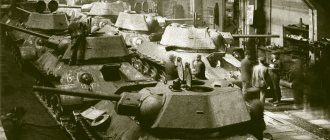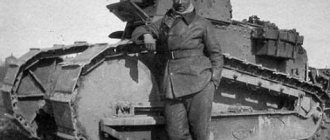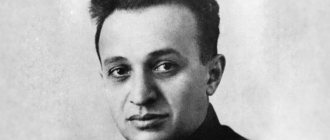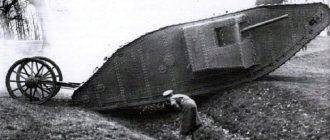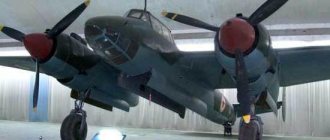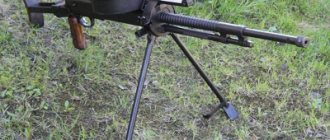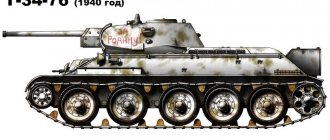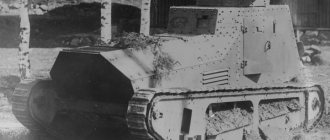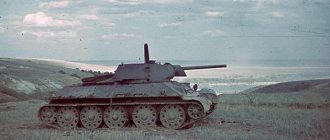The 80th anniversary of the beginning of the Great Patriotic War is marked by a number of important dates that are associated with historical events that influenced the course of the war. One of these events was the evacuation of the Kharkov Locomotive Plant and tank design bureau to the Urals, which made it possible to continue and increase the production of T-34 tanks.
“Reedus” talked with Yuri Apukhtin, who worked for a long time at the Kharkov Mechanical Engineering Design Bureau named after Morozov, about how the victory was forged in the rear, about the history of the legendary “thirty-four” and the enterprise that produced it.
[edit] History
Main article
:
History of tank building in Russia
The first production tank in Russia came out of the gates of the Sormovo plant on August 31, 1920. He received the name “Freedom Fighter Comrade. Lenin." In fact, it was a copy of the French FT-17 tank from Renault, only with some improvements.[2]
4 years after the release of the first Russian-assembled tank, in 1924 the country began designing entirely domestic tanks.[3]
MS-1, T-12 and T-24 appeared. Foreign tank building experience was also carefully studied. Individual samples of tanks were purchased from the West, specifically individual ones, in order to study their design and subsequently use the advanced technical solutions available in them, and mastered their production at home.[4]
With the birth of the T-34 and tanks, which became symbols of victory in World War II, the USSR became one of the world leaders in tank building, a trendsetter in its own way. Potential opponents of the USSR copied the technical innovations used in Soviet tanks, knowing full well, based on the experience of World War II, that tanks had become critical on the battlefield, and especially with the advent of nuclear weapons in arsenals.[5]
Soviet designers of combat vehicles continued to amaze with more and more new designs of their creations. The revolutionary T-64, multi-axle wheeled amphibious armored personnel carriers and a new class of armored vehicles - infantry fighting vehicles - determined global trends in the development of armored vehicles for decades. The experience of the Soviet school of tank building has turned into a world classic.[6]
In the USSR, for the first time, smooth-bore guns, combined multi-layer armor, automatic loading systems, gas turbine power plants, anti-nuclear protection systems, underwater driving, dynamic, active protection and optical-electronic suppression systems, and much more were used on tanks. It was the USSR that created and tested the first automated battle and fire control systems, tele-controlled tanks capable of fighting without crews inside. In the West at the same time, they were just developing the ideology of building such systems.[7]
Demidov millions
The entire pre-revolutionary history of Nizhny Tagil is connected with metal. The founding date of the city is considered to be October 8, 1722, when the first blast furnace was launched at the Vyya copper smelter. In 1725, after the copper smelter, the Nizhny Tagil ironworks was launched. At that time it was the most powerful and modern plant in Europe, surpassing Swedish factories in production volume and product quality. The founder of Yekaterinburg, a well-known expert in mining, General Wilhelm de Gennin, in the “Description of the Ural and Siberian factories” for 1735, reports that from one blast furnace of the Tagil plant they received from 250 to 400 pounds of cast iron. And the blast furnace at the plant in Sweden then produced an average of 200 - 210 poods. In addition, production in Nizhny Tagil was less energy-intensive: in Swedish furnaces, 300-350 kg of charcoal were spent to produce 100 kg of cast iron, in Tagil - half as much.
The quality of Tagil metal has been repeatedly confirmed at international exhibitions. At the World Exhibition in London in 1851 there were three bronze medals, in Paris in 1867 three gold medals, and in 1878 at the World Exhibition in Paris, Old Sable steel received the Grand Prix. The mark with the image of a sable, symbolizing the softness and quality (like noble sable fur) of Tagil iron, and the letters S.S.N.A.D. - State Councilor Nikita Akinfievich Demidov, was known to the whole world.
The city itself gained worldwide fame in 1834, when mechanics Efim Alekseevich and Miron Efimovich Cherepanov created the first steam locomotive in Russia. Thanks to Tagil craftsmen and the support of the owners of the plant - the Demidovs - Russia became the only country in Europe that had its own steam locomotives, and not those imported from England. For almost two hundred years, the steam locomotive was a symbol of progress and industrial development in Russia and a Tagil brand of national significance.
At the Paris exhibition of 1867, a malachite block weighing 4.8 tons found in a Tagil copper mine was exhibited. Of course, the high quality of the metal was based not only on advanced technology, but also on the iron-rich ore extracted from Mount Vysokaya. The deposit was discovered in 1697, exploration was carried out on the direct orders of Peter I: the sovereign was then fighting for access to the sea and set the task of developing his own industry. Now, in place of the mountain, there is a deep, almost kilometer-long quarry: “There was a mountain called Vysoka, but the hole has become deep.”
Before the establishment of Soviet power, metallurgy was associated exclusively with the family of Demidov factory owners, the founders of the city. For ideological reasons, the role of the Demidovs in the creation and formation of Nizhny Tagil was hushed up by the Soviet authorities, and in 1930, when a new stage of the anti-religious policy of the Soviet state began, the Demidov family tomb in the Vyisko-Nikolskaya Church was looted. At first they wanted to convert the church itself into a school, then they made it a warehouse, and in 1967, for the anniversary of Soviet power, a palace of culture was built in its place. Today the Demidovs have experienced historical rehabilitation: in the center of the city there is a monument, although not to the founder of the dynasty, Nikita Demidov, but to one of his active descendants, Nikolai, a hero of the War of 1812, who at one time served as an aide-de-camp to Prince Potemkin. Why exactly to him is a controversial question, discussed among historians and local historians. Perhaps they took into account the fact that the gunsmith Nikita Demidych Antyufeev (he received the surname Demidov with the title of nobility assigned to him and his descendants) already has a monument in his homeland in Tula.
Seven generations of Demidovs owned Tagil factories. The most outstanding of the Demidovs after the founding father of the dynasty was his son Akinfiy, a real workaholic, who multiplied and developed the inherited mining empire to the scale of, as we would now say, a large federal holding. The last owner of the factories was Elim Demidov, who had visited Tagil once in his entire life and already spoke Russian poorly. Starting from the third generation, the Demidovs lived constantly in Moscow, St. Petersburg and abroad, and had an enormous fortune for those times. Akinfiy’s son Procopius spent 4 million rubles on charity alone—a gigantic sum at that time. He also became famous for his extravagant antics. The most famous of them is the winter road in summer in Moscow. Procopius ordered the mile of the road to be covered with salt, got into the carriage and rushed off dressed in a fur coat with songs and bells. There were men standing along the road, also dressed in winter clothes. After the master rushed off, they collected as much salt as they could into bags and took it with them - salt in those days was not cheap.
[edit] T-14
Tank T-14
Main article
:
T-14
The main tank based on the Armata platform will be equipped with a 125mm gun, which has been a standard Soviet-made weapon since the 1960s. However, the gun will have an uninhabited turret, and the crew will be housed in a separate armored capsule, a unique arrangement not found on any modern main battle tank.[8]
Armor occupies a special place in the design of the Armata: a multilayer “pie” of metal, ceramics and composites. It is based on new armor steel grade 44S-sv-Sh, created by specialists from OJSC Research Institute of Steel, which is capable of increasing the armor properties of equipment by more than 15%. The use of this steel allowed the developers to reduce the weight of the structure by 15% while maintaining the required level of armor penetration.[9]
It is expected that the Armata will have a fully digital combat information and control system. In aviation it is also called “digital board”. With its help, the machine is started, controlled, diagnosed and adjusted. That is, in the event of a breakdown, it will not be the crew or the repair team who will decide what needs to be repaired, but the electronics. A similar solution was implemented on the latest German tank Leopard 2A6.[10]
The Armata, like the T-50 fighter, will be equipped with the latest active phased array radar (AFAR). There are no such solutions on any tank in the world. The system is capable of simultaneously tracking up to 40 dynamic and up to 25 aerodynamic targets, monitoring an area within a radius of up to 100 kilometers and automatically destroying targets up to 0.3 meters in size. Thanks to the presence of an AFAR, the Armata is positioned as a universal strike vehicle of the ground forces, including a full-fledged tactical missile system, an anti-aircraft air defense system, an army reconnaissance and target designation complex and a tank itself.[11]
To solve these problems, the Armata will be equipped with a new 125-mm 2A82 cannon. In terms of its characteristics, it surpasses the German 120-mm L-55 barrel installed on the Leopard 2A6 tank. In terms of technical level, the gun's developers say, the 2A82 is 1.2 times superior to all Western tank guns, and the German barrel itself is 1.17 times superior. Moreover, the Russian product is also 60 cm shorter.[12]
Ammunition with increased firepower has been developed for the new gun for the Armata. All of them were put into service back in 2013.[13]
It is known about the Armata that the tank will have a classic six-wheel design. Inside the tank there will be a new 12-speed automatic transmission with manual shifting and a new A-85-3A engine with 1,500 hp. To increase its resource, it was “strangled” to 1200 hp. For comparison, on the T-90 (weighs 46.5 tons) the power plant has a power of 1000 hp. With. In terms of size, weight and power characteristics, the Armata's chassis should surpass the best foreign examples of engine-transmission units.[14]
In addition to the cannon, the Armata will be equipped with a coaxial 7.62 mm PKTM machine gun and a 12.7 mm Kord machine gun. They are located outside the tower on separate rotating modules. It will be controlled by the crew remotely using computers and electric drives. This means that during shooting, military personnel will not have to lean out of the hatch. Battle-ready ammunition - 1000 rounds. Another 1000 are stored in a spare parts box at the rear of the turret.[15]
Memory of the great design team
“Reedus”: Who from the Morozov team, from the participants in those events, did you communicate with?
Yuri Apukhtin: When I came to work in 1972, I found more people who were evacuated. I have already talked about Polyakov. I also talked with the head of the advanced design department Omelyanovich. Quite often - with Baisov. They talked about all the problems of the war years.
I must also say about the head of the loading mechanism department, Nabutovsky. It was he who later developed the loading mechanism for the T-64 tank. I had to contact him quite often. Instead of a cardan shaft for the mechanism for counting shells located in the conveyor of the loading mechanism, I developed an automatic counting system. Nabutovsky told how difficult it was to work in Tagil: although they all had increased nutrition because they were engaged in the production of military equipment, this was very little. And people tried to plant vegetable gardens next to the barracks in which they lived, grew something... Employees of the plant and design bureau had to go to the front to modernize tanks.
Few people know that after the war the design bureau (which now bears the name of Morozov) returned to Kharkov not in 1945, but only in 1951. Morozov was the first to return: he was seriously ill and had surgery in Moscow. And then they slowly began to return all the specialists. It surprised me, to be honest. I still don’t understand: what was the point of keeping them there? Kharkov is not Tagil. But people were not released. Everyone knows that due to secrecy, everyone was forbidden to leave Sarov, where the Soviet atomic bomb was developed. And even tankers were not allowed to go home from Tagil until 1951. That is, people had to live in evacuation for ten years. These are employees of the design bureau, the plant, and their families. Children from first to tenth grade could study in Tagil.
When I was a young specialist, I was lucky to work on one of the topics under the guidance of Alexander Morozov himself. Koshkin's deputy, one of the authors of the T-34, and then the chief designer of the T-64 tank.
Yuri Apukhtin near the Memorial to Soviet Tankmen.
© Photo from the personal archive of Yuri Apukhtin
One of the first works in which I participated was the creation of the “Tucha” grenade launcher. Now all tanks have such short barrels for launching smoke grenades, and then aerosol grenades (for protection against ATGMs that fly into the tank). So I participated in the development of this system. There were problems: the contact device in this grenade launcher did not work well. And we had to develop variants of this contact device. And these works were supervised by Morozov himself. He made me develop 24 design options! For my anniversary, the KB later gave me an album with all these options filed in it. And so Morozov was looking for a simple, reliable solution. When a grenade flew out, the powder charge exploded, pieces of duralumin remained in the grenade launcher - and a short circuit occurred. We searched and eventually found a solution that was very simple, even primitively simple. It was around 1973 or 1974 when I was working under this truly brilliant man.
I remember a rather interesting incident. I had to go to Moscow on some issue regarding the element base for the new system. We didn't know the exact name of the company. We tried to contact the ministry, but the person we needed was not there. I wrote an order where I did not indicate the enterprise I was going to and did not indicate the purpose. They gave it to Morozov for signature. The secretary calls and invites me to Morozov. He asks: “Did you write the order? Where are you going?" I answer: “It’s not clear yet, we don’t know the name of the enterprise. We’ll sort it out in Moscow.” Morozov says: “Look: I’ll sign now... Then you’ll go and write: he’s on a business trip to Moscow to blow up Lenin’s mausoleum. And I, Morozov, signed…” That is, he was so scrupulous about every little detail. Then Morozov says: “Let’s call the ministry and find out.” He always paid attention to every little thing.
There were a lot of problems when creating the T-64. The tank is completely new. And the military mission from Moscow constantly put pressure on Morozov: this must be done, this must be done. But everything doesn’t work out. And one day at a meeting (later Morozov’s deputy told me) one of the colonels began: “This can be done. Why don’t you do it?” Morozov took a pencil and said: “Here’s a pencil for you, take it and do it if you’re so smart.”
Morozov was rooting for the cause, rooting for the tank. I worked in a design bureau under three chief designers. Morozov is the only one whose meaning in life was to create new machines. A man returns from a business trip, from Moscow. You can go to work the next day. The train arrived in Kharkov at 8:30 am. And already at ten in the morning Morozov was at work, delving into the essence of the question: how, where, what was being done.
The T-64 was a fundamentally new generation of vehicles, the idea belonged to Morozov. What was it? A completely new engine was created, which had previously been used on German aircraft. This is a flat engine, which allowed the silhouette of the car to be significantly reduced. For the first time, a 125 mm tank gun was used, and a loading mechanism was introduced. They threw out the crew member - the loader. A new sighting system, a fundamentally new layout of the power compartment, final drives and gearbox - this has never happened before.
[edit] Production of components
[edit] Guns
Main article
:
Production of tank guns in Russia
Production of 2A82 guns (installed on the T-14 tank) is carried out at Plant No. 9 in Yekaterinburg.[16]
[edit] Active protection complexes
The Afghanit active protection complex (used on the T-14 tank) was developed at the Kolomna Mechanical Engineering Design Bureau.[17]
[edit] Dynamic protection
Dynamic protection units for tanks are being developed at JSC Research Institute of Steel.[18]
[edit] Armor steel
Armor steel grade 44S-SV-Sh (used on the T-14 tank) was created by specialists from JSC Research Institute of Steel.[19]
[edit] Engines
Main article
:
Production of tank engines in Russia
The A-85-3A diesel turbopiston engine (installed on the T-14 tank) was developed by the Chelyabinsk GSKB Transdiesel. Produced at the Chelyabinsk Tractor Plant.[20]
[edit] Links
[edit] Video
- Tank assembly. December 23, 2013
- Russian tanks - production. December 23, 2012
[edit] Runet
- Section about tank building on the Armyprom website
- Russian tank building at the beginning of the 21st century
- T-64, T-72 or T-80, which is better?
- DEPLOYMENT OF NEW TYPES OF TANKS IN GSVG/ZGV
- Impartially about the Oplot-M and T90MS tanks. September 6, 2012
- Reflections on the T-84 and T-90
- The secret weapon of the Russian army: the Armata program (The National Interest, USA). November 21, 2014
- Simferopol began producing high-precision angular sensors for Armata tanks. May 27, 2015
- The newest tanks of Russia. January 4, 2015
- UVZ started transforming the T-90 tank into a robot. October 12, 2015
- T-90SM with the Ainet complex will be a real curse for the enemy. February 18, 2015
- American missile against the latest Russian tank. February 29, 2016
- What happened to the Russian T-90, shot down by an American missile in Syria. March 1, 2016
- T-72B3
- Tank building
[edit] Other
- Russian Armour. May 13, 2015
- Soviet tanks of World War II
Megabuildings
On August 20, 1919, by decree of the Yekaterinburg Military Revolutionary Committee, the “district-free city of Nizhny Tagil” was formed by the merger of three volosts (Vyisko-Nikolskaya, Tagilskaya and Troitskaya). After the revolution and the Civil War, the city was drained of blood, the factories were barely warm, and the mine was flooded. Many people left with the White troops, driven out of the city by the Reds in October 1918. The beginning of the 20s was marked by the fight against homelessness, the creation of an experimental Children's Town, where street children and juvenile delinquents were taken, whom the police caught in the gateways and gangster raspberries. In 1923, this new educational institution created by the Soviet government was visited by the People's Commissar of Education Lunacharsky. “Indeed, I could not help but be pleased with this institution. It is still very young, it has existed for the first year, much of it is still not good; Children, as almost everywhere in the Urals, have very few shoes: many are barefoot. The power supply is also intermittent. But the pedagogical side is excellent,” wrote Anatoly Vasilyevich in one of his articles.
A new impetus for the development of the city was given in the early 30s of the last century. On May 15, 1930, the Central Committee of the All-Union Communist Party of Bolsheviks decided to create a second coal and metallurgical base in the USSR. The XVI Party Congress, held in June-July, considered issues of further economic development of the country and decided to speed up the construction of the Magnitogorsk and Kuznetsk plants and begin construction of the Novo-Tagil Metallurgical Plant (NTMZ). Construction for those shock years took a long time, stopped several times, the design was changed, so the first blast furnace of NTMZ produced the first cast iron only on June 25, 1940.
The second mega-construction began in Tagil in 1931. This is the Ural Carriage Works (UVZ) - the largest enterprise in the world, which was later included in the Guinness Book of Records. The date of birth of the plant was October 11, 1936, when the first products rolled off the car assembly line. During the years of shock construction, the population of Nizhny Tagil increased significantly. Largely due to the so-called special settlers, mainly peasants, “dispossessed” during collectivization and sent to great construction projects as free labor. Five years after the start of construction of the UVZ (and construction began in an open field, more precisely, in the forest), the Dzerzhinsky district of Nizhny Tagil (popularly called Vagonka) with a population of 45 thousand people appeared. “The new city - Dzerzhinsky district - has 600 houses, 20 streets, nine schools, a telephone exchange with 900 numbers, 87 shops, two clinics, a club, and a cultural park. Representatives of 23 nationalities live in the area,” wrote the Tagilsky Rabochiy newspaper in September 1936.
It was then, in the 30s, that provincial Nizhny Tagil, which had been in economic stagnation since the early 20s, where long-outdated factories were chugging along, once again found itself involved in the turbulent flow of domestic and world history.
[edit] Notes
- Uralvagonzavod is negotiating the purchase of Amurmetal
- The armor is strong, but the West is dearer to us. 09/10/2010
- The armor is strong, but the West is dearer to us. 09/10/2010
- The armor is strong, but the West is dearer to us. 09/10/2010
- The armor is strong, but the West is dearer to us. 09/10/2010
- The armor is strong, but the West is dearer to us. 09/10/2010
- The armor is strong, but the West is dearer to us. 09/10/2010
- Media: American experts are concerned about the power of Russian Armata tanks. November 21, 2014
- “Armata” versus “Leopard”: the new Russian tank will surpass all world analogues. November 22, 2014
- “Armata” versus “Leopard”: the new Russian tank will surpass all world analogues. November 22, 2014
- “Armata” versus “Leopard”: the new Russian tank will surpass all world analogues. November 22, 2014
- “Armata” versus “Leopard”: the new Russian tank will surpass all world analogues. November 22, 2014
- “Armata” versus “Leopard”: the new Russian tank will surpass all world analogues. November 22, 2014
- “Armata” versus “Leopard”: the new Russian tank will surpass all world analogues. November 22, 2014
- “Armata” versus “Leopard”: the new Russian tank will surpass all world analogues. November 22, 2014
- Tank T-14 "Armata" or T-99 "Priority"
- Tank T-14 "Armata" or T-99 "Priority"
- Tank T-14 "Armata" or T-99 "Priority"
- Tank T-14 "Armata" or T-99 "Priority"
- Tank T-14 "Armata" or T-99 "Priority"
- Oleg Sienko: The handmade Armata is three times cheaper than the Abrams. April 18, 2016
| Military-industrial complex of Russia | |
| Story | 1990s (1990, 1991, 1992, 1993, 1994, 1995, 1996, 1997, 1998, 1999) • 2000s (2000, 2001, 2002, 2003, 2004, 2005, 2006, 2007 , 2008, 2009 , 2010, 2011, 2012, 2013, 2014, 2015, 2016, 2017, 2022, 2022, 2020) |
| Aircraft industry | Aircraft manufacturing • Helicopter manufacturing |
| Shipbuilding | Surface shipbuilding • Submarine shipbuilding |
| Other industries | Tank building • Production of air defense equipment |
| Companies | Rostec • Oboronprom • VSMPO-Avisma • RusSpetsStal • ODK-Saturn • Motorostroitel • Almaz-Antey • Motovilikha Motors • Uralvagonzavod • Tactical missile weapons • Northern Machine-Building Enterprise • Amur Shipbuilding Plant • Arzamas Machine-Building Plant • Instrument Design Bureau • Mechanical Engineering Design Bureau • Kurgan Machine-Building Plant plant • NPO Mashinostroyenia |
| Central Federal District | Belgorod region • Bryansk region • Vladimir region • Voronezh region • Ivanovo region • Kaluga region • Kostroma region • Kursk region • Lipetsk region • Moscow region • Oryol region • Ryazan region • Smolensk region • Tambov region • Tver region • Tula region • Yaroslavl region • Moscow |
| Northwestern Federal District | Karelia • Komi • Arkhangelsk region • Nenets Autonomous Okrug • Vologda region • Kaliningrad region • Leningrad region • Murmansk region • Novgorod region • Pskov region • St. Petersburg |
| Southern Federal District | Adygea • Kalmykia • Krasnodar region • Astrakhan region • Volgograd region • Rostov region |
| KFO | Crimea • Sevastopol |
| North Caucasian Federal District | Dagestan • Ingushetia • Kabardino-Balkaria • Karachay-Cherkessia • North Ossetia • Chechnya • Stavropol Territory |
| Volga Federal District | Bashkortostan • Mari El • Mordovia • Tatarstan • Udmurtia • Chuvashia • Perm region • Kirov region • Nizhny Novgorod region • Orenburg region • Penza region • Samara region • Saratov region • Ulyanovsk region |
| Ural Federal District | Kurgan region • Sverdlovsk region • Tyumen region • Khanty-Mansi Autonomous Okrug • Yamalo-Nenets Autonomous Okrug • Chelyabinsk region |
| Siberian Federal District | Altai • Buryatia • Tyva • Khakassia • Altai region • Transbaikal region • Krasnoyarsk region • Irkutsk region • Kemerovo region • Novosibirsk region • Omsk region • Tomsk region |
| Far Eastern Federal District | Yakutia • Kamchatka Territory • Primorsky Territory • Khabarovsk Territory • Amur Region • Magadan Region • Sakhalin Region • Jewish Autonomous Region • Chukotka Autonomous Okrug |
Source - ""
Category: Russian tank building
